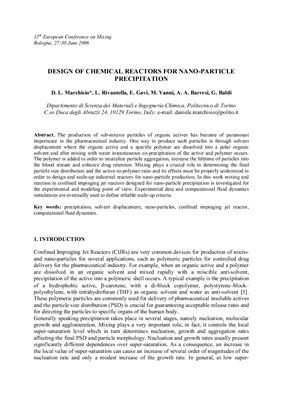12th European Conference on Mixing, Bologna, 27-30 June 2006
The production of sub-micron particles of organic actives has become of paramount
importance in the pharmaceutical industry. One way to produce such particles is through solvent
displacement where the organic active and a specific polymer are dissolved into a polar organic
solvent and after mixing with water instantaneous co-precipitation of the active and polymer occurs.
The polymer is added in order to neutralize particle aggregation, increase the lifetime of particles into the blood stream and enhance drug retention. Mixing plays a crucial role in determining the final particle size distribution and the active-to-polymer ratio and its effects must be properly understood in order to design and scale-up industrial reactors for nano-particle production. In this work mixing and reaction in confined impinging jet reactors designed for nano-particle precipitation is investigated for the experimental and modeling point of view. Experimental data and computational fluid dynamics simulations are eventually used to define reliable scale-up criteria.
The production of sub-micron particles of organic actives has become of paramount
importance in the pharmaceutical industry. One way to produce such particles is through solvent
displacement where the organic active and a specific polymer are dissolved into a polar organic
solvent and after mixing with water instantaneous co-precipitation of the active and polymer occurs.
The polymer is added in order to neutralize particle aggregation, increase the lifetime of particles into the blood stream and enhance drug retention. Mixing plays a crucial role in determining the final particle size distribution and the active-to-polymer ratio and its effects must be properly understood in order to design and scale-up industrial reactors for nano-particle production. In this work mixing and reaction in confined impinging jet reactors designed for nano-particle precipitation is investigated for the experimental and modeling point of view. Experimental data and computational fluid dynamics simulations are eventually used to define reliable scale-up criteria.

